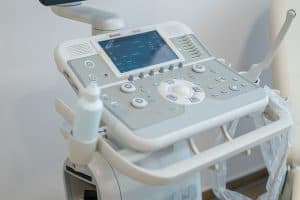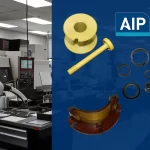
At AIP Precision Machining, we’ve seen firsthand how the medical device industry is transforming through the integration of precision engineering and advanced materials. A material that’s central to this evolution is PEEK (Polyetheretherketone), a high-performance polymer that we specialize in machining to meet the exacting standards of medical applications.
PEEK’s unique properties—like its biocompatibility, radiolucency, and biostability—make it an ideal choice for medical implants and instruments, helping to enhance patient safety and improve clinical outcomes in orthopedic and other critical applications.
In this article, we’ll take you through the vital role that PEEK polymers play in many of the medical devices we’ve produced at AIP. We’ll detail the distinct properties of PEEK, its applications, and the precise manufacturing processes we use to ensure each component meets the highest standards of quality and performance.
We’ll also explore how PEEK compares to traditional materials, discuss future trends in PEEK-based medical devices, and provide insights into the regulatory landscape, including our commitment to FDA compliance and ISO 13485 standards. Additionally, we’ll cover the use of PEEK in minimally invasive surgical instruments, focusing on the clinical benefits and human factors that drive our work at AIP. Through this exploration, we aim to highlight the crucial role PEEK and our team at AIP Precision Machining play in advancing medical technology.
Key Takeaways
| Key Takeaway | Description |
| Role of Precision Engineering | Precision engineering is crucial in developing reliable and safe medical devices. |
| PEEK’s Unique Properties | PEEK offers biocompatibility, radiolucency, and biostability, making it ideal for medical implants and instruments. |
| AIP’s Expertise | AIP specializes in machining high-performance polymers like PEEK to meet stringent medical standards. |
| Regulatory Compliance | AIP adheres to FDA compliance and holds ISO 13485 certification, ensuring high-quality production. |
| Comparison to Traditional Materials | PEEK outperforms traditional materials in many aspects, including safety and effectiveness. |
| Applications in Minimally Invasive Surgery | PEEK is increasingly used in minimally invasive surgical instruments due to its beneficial properties. |
| Future Trends in PEEK Devices | The article discusses future trends and the growing importance of PEEK in advancing medical technology. |
| Clinical Benefits and Human Factors | The use of PEEK in medical devices leads to improved clinical outcomes and consideration of human factors. |
Properties and Advantages of PEEK for Medical Devices
At AIP Precision Machining, we’ve long recognized the critical role that material selection plays in the development of medical devices. PEEK’s unique combination of biocompatibility, radiolucency, and mechanical strength provides significant advantages in the design and manufacturing of medical implants and instruments. In this section, we’ll explore the key properties of PEEK that contribute to its effectiveness in medical applications and highlight the advantages that have made it a go-to material for ensuring patient safety and improving clinical outcomes.
Biocompatibility and mechanical strength
PEEK (Polyetheretherketone) is a high-performance thermoplastic polymer widely used in medical devices due to its exceptional properties. It has an elastic modulus similar to human bone, reducing stress shielding issues present in metal implants. PEEK’s biocompatibility meets ISO 10993 and USP Class VI requirements, making it safe for long-term implantation. Its mechanical strength is comparable to enamel, bone, and dentin, making it suitable for dental restorations, orthopedic implants, and spinal fusion devices.
Chemical and thermal resistance
PEEK demonstrates excellent chemical resistance, withstanding most solvents except highly concentrated acids. It remains insoluble in biological fluids, ensuring long-term stability in the body. With a melting point of 343°C, PEEK can endure up to 3,000 cycles of high-pressure sterilization at 134°C, making it ideal for surgical and dental equipment requiring repeated use and high sterility.
Radiolucency and sterilization compatibility
PEEK’s radiolucency is a significant advantage for medical imaging, as it does not produce metal artifacts during MRI or CT scans. This property facilitates postoperative observation and is particularly beneficial for orthopedic and spinal implants. PEEK’s resistance to electron beam and gamma radiation ensures its structure remains unaffected during sterilization processes, making it compatible with various sterilization methods used in the medical industry.
Applications of PEEK in Medical Implants and Instruments
PEEK (Polyetheretherketone) has established itself as a leading material in the medical field, particularly in the design and manufacturing of implants and instruments. Its unique properties, such as biocompatibility, durability, and resistance to wear and chemical degradation, make it an ideal choice for various medical applications.
From spinal implants and dental devices to surgical instruments and orthopedic components, PEEK’s versatility and reliability have led to its widespread adoption across the healthcare industry. In this section, we’ll delve into the specific applications of PEEK in medical implants and instruments, showcasing how this advanced polymer enhances patient outcomes and supports the development of innovative medical technologies.
Orthopedic and spinal implants
PEEK has become a preferred material for orthopedic and spinal implants due to its biocompatibility and mechanical properties similar to human bone. PEEK-OPTIMA™ Natural polymer, with over twenty years of clinical history, is widely used in spinal fusion surgeries, accounting for 50% of all interbody fusion devices. Its elastic modulus, comparable to cortical bone, reduces stress shielding issues present in metal implants. Carbon-fiber reinforced PEEK further enhances its mechanical properties, making it suitable for load-bearing applications such as joint replacements and fracture fixation devices.
Dental applications
In dentistry, PEEK has gained popularity for its esthetic properties, biocompatibility, and ease of machining. It is used for crowns, bridges, and other dental prosthetics. PEEK’s low specific weight allows for lightweight prostheses, enhancing patient comfort. While its grayish-brown color may limit use in anterior teeth, surface conditioning methods have been developed to improve bonding with resin composites for better aesthetics. PEEK has also shown promise in implant healing abutments and removable partial denture frameworks, eliminating metallic taste and allergic reactions.
Surgical instruments and device components

PEEK’s durability, chemical resistance, and ability to withstand sterilization make it ideal for surgical instruments and device components. It is increasingly replacing metal instruments in operating rooms, offering advantages such as lighter weight (up to 70% lighter than stainless steel) and radiolucency. PEEK is particularly suitable for endoscopes and other instruments requiring repeated sterilization. Its processability allows for complex shapes and integrated parts, enabling innovative instrument designs. PEEK’s use extends to medical device housings, including handheld surgical tools and electronic monitoring equipment, due to its strength and biocompatibility.
Future Trends and Innovations in PEEK Medical Devices
The landscape of medical device technology is constantly evolving, and PEEK (Polyetheretherketone) is at the forefront of this progress. As a material that has already proven its worth in a wide range of applications, PEEK continues to drive innovation in the medical field. Future trends indicate a growing use of PEEK in areas such as minimally invasive surgery, personalized implants, and advanced prosthetics.
With ongoing research and development, new formulations and manufacturing techniques are expanding the possibilities of what PEEK can achieve. In this section, we’ll explore the emerging trends and innovations in PEEK-based medical devices, highlighting how this versatile polymer is set to play an even more critical role in the future of healthcare.
3D printing of customized PEEK implants
3D printing technology has revolutionized the manufacturing of customized PEEK implants. This innovation allows for greater design freedom, reduced waste, and lighter implants, enhancing performance and patient satisfaction. 3D-printed PEEK implants are primarily used in spine surgery, prosthetics, fracture fixation, and reconstruction of complex calvarial and maxillofacial defects. The FDA clearance of VSP PEEK Cranial Implant solution marks a significant milestone, setting a new standard for cranioplasties.
Nanocomposite PEEK materials
Researchers are developing PEEK nanocomposites to enhance bioactivity and mechanical properties. Incorporating bioactive materials such as hydroxyapatite (HA), titanium dioxide, and bioglass into PEEK improves cell attachment, proliferation, and osteogenic activity. These composites aim to overcome PEEK’s bioinertness and hydrophobicity, promoting better osseointegration. However, balancing improved biological properties with optimal mechanical characteristics remains a challenge in nanocomposite development.
Antimicrobial and drug-eluting PEEK
To address the risk of implant-associated infections, researchers are exploring antimicrobial and drug-eluting PEEK materials. These innovations involve modifying PEEK surfaces or incorporating antibacterial substances into the polymer matrix. The goal is to create implants that can deliver higher concentrations of antibiotics to infection sites while maintaining PEEK’s favorable biomechanical properties. This approach offers a promising solution for managing localized bone infections and reducing the incidence of systemic adverse reactions.
PEEK vs Traditional Materials in Medical Devices
At AIP Precision Machining, we understand that the choice of materials is crucial in the development of high-performance medical devices. The inherent properties of PEEK, such as its strength, biocompatibility, and resistance to wear and chemical degradation, offer clear advantages over metals and other conventional polymers.
In this section, we’ll compare PEEK with traditional materials, examining how it outperforms them in various medical applications and why it has become a preferred choice for manufacturers committed to innovation and patient safety.
Comparison with metals
PEEK’s elastic modulus (8.3 GPa) is closer to human bone (17.7 GPa) than metal alloys (116 GPa), reducing the risk of stress shielding and bone resorption. Unlike metals, PEEK is radiolucent, allowing better visualization of bone tissue in X-ray, CT, and MRI scans. It also eliminates issues associated with metal implants, such as corrosion, allergic reactions, and metal ion release.
Advantages over other polymers
PEEK’s exceptional heat tolerance, chemical resistance, and stable structure enhance its strength and durability. It withstands harsh conditions at elevated temperatures, making it suitable for sterilization processes. PEEK’s low permeability, resistance to steam and water, and minimal moisture absorption further contribute to its superiority in medical applications.
Cost-benefit analysis
While initial costs may be higher, PEEK’s long-term benefits include reduced complications, improved patient outcomes, and potential cost savings in follow-up treatments. Its lightweight nature and ease of processing also offer ergonomic and manufacturing advantages over traditional materials.
Manufacturing Processes for PEEK Medical Devices
The manufacturing of PEEK (Polyetheretherketone) medical devices demands precision and expertise, given the material’s unique properties and the stringent requirements of the medical field. At AIP Precision, we are equipped with advanced capabilities to handle the complexities of machining PEEK to exacting standards.
Our ISO 13485 certification underscores our commitment to quality and regulatory compliance, ensuring that every PEEK component we produce meets the highest standards for medical applications.
In this section, we’ll explore the specialized manufacturing processes we employ at AIP, from precision machining to finishing techniques, all designed to maximize the performance and reliability of PEEK-based medical devices.
Injection molding
Injection molding is a key process for producing PEEK medical devices. It involves melting PEEK resin pellets and injecting the molten material into a mold cavity at high pressure. This method is suitable for creating parts with high strength, stiffness, and dimensional stability. The process requires careful control of temperature, with processing temperatures ranging from 350°C to 400°C. Molds must be kept at temperatures up to 200°C to prevent defects. Proper drying of PEEK resin to less than 0.02% moisture content is crucial before molding.
Machining and CNC
CNC machining of PEEK offers high accuracy, repeatability, and tight tolerances. This process involves computer-controlled removal of layers from PEEK material. Silicon carbide cutting tools are typically used for natural PEEK, while diamond tools are preferred for carbon fiber-reinforced PEEK. Annealing before machining is critical to relieve stress and reduce the likelihood of surface cracks. Cooling during machining is necessary, with air cooling often preferred for medical-grade PEEK to maintain biocompatibility.
Additive manufacturing
Additive manufacturing, particularly Fused Filament Fabrication (FFF) and Selective Laser Sintering (SLS), has gained traction for producing PEEK medical devices. FFF, which uses continuous PEEK filaments, is routinely applied in clinical trials due to its ability to control PEEK crystallization. This method allows for the creation of complex, patient-specific geometries, especially beneficial for implants such as spine cages and cranial implants. Post-processing, including heat treatment for controlled recrystallization, is often performed to enhance the properties of 3D-printed PEEK implants.
Regulatory Considerations for PEEK Medical Devices
The FDA categorizes PEEK medical devices as Class II or III, requiring rigorous approval processes. Class II devices typically undergo 510(k) clearance, demonstrating substantial equivalence to predicate devices. Class III devices, posing higher risks, require premarket approval (PMA). PEEK implants must meet ISO 10993 guidelines for biocompatibility, ensuring safety for long-term use. Biocompatibility testing includes cytotoxicity, sensitization, and implantation studies. Manufacturers often collaborate with polymer converters to access crucial data on PEEK’s properties and biocompatibility, facilitating smoother regulatory processes. This comprehensive approach ensures PEEK medical devices meet stringent safety and efficacy standards before market introduction.
PEEK in Minimally Invasive Surgical Instruments
PEEK has become a material of choice for minimally invasive surgical (M.I.S.) instruments due to its exceptional properties. Its high strength, biocompatibility, and resistance to chemicals and sterilization make it ideal for various applications.
Endoscopic and laparoscopic tools
PEEK’s high flexural modulus of 595,000 psi (4,102 MPa) provides excellent pushability and buckling resistance for thin-walled tubes used in endoscopic and laparoscopic procedures. These tools benefit from PEEK’s strength, flexibility, and ability to withstand repeated sterilization cycles.
Catheter components
PEEK’s low coefficient of friction (around 0.35) makes it suitable for catheter applications, particularly in neurovascular procedures. It allows smooth movement through blood vessels without the need for coatings or lubricious liners. PEEK catheters offer strong, flexible, small-diameter tubing with high burst pressure performance.
Imaging device housings
PEEK is utilized in the manufacturing of housings for various medical devices, including handheld surgical tools and electronic monitoring equipment. Its mechanical strength, resistance to sterilization, and biocompatibility make it an excellent choice for these applications, especially in MRI-compatible devices.
Clinical Outcomes and Patient Benefits of PEEK Devices
PEEK devices offer significant advantages in medical applications, particularly in orthopedics and spinal implants. The elastic modulus of PEEK (3-4 GPa) closely matches that of human cortical bone (18 GPa), unlike titanium alloys (110 GPa). This similarity reduces stress shielding, a common issue with metal implants. PEEK’s radiolucency allows for clearer post-operative imaging, facilitating better monitoring of healing progress. However, PEEK’s biological inertness can lead to complications in some cases, with studies reporting post-operative issues in 15.3% of PEEK cranioplasty patients. Despite this, PEEK’s overall benefits in stress distribution and bone mass preservation make it a promising material for patient-specific implants.
Conclusion
The groundbreaking use of PEEK polymers in medical devices continues to have a profound impact on patient care and clinical outcomes. With its unique properties—biocompatibility, radiolucency, and mechanical strength akin to human bone—PEEK has proven to be an ideal material for a wide range of medical applications, from orthopedic implants to advanced surgical instruments. Its versatility and performance are driving innovation across the medical device industry, shaping the future of healthcare.
As the field progresses, emerging trends like 3D-printed PEEK implants and nanocomposite PEEK materials offer exciting possibilities for patient-specific solutions and enhanced long-term outcomes. To fully leverage these advancements, it is essential to collaborate with experts who understand the material and its potential.
At AIP Precision Machining, we specialize in precision-engineering high-performance PEEK components for the medical industry. With over 40 years of expertise and certifications such as ISO 13485, we ensure that your medical devices meet the most stringent quality and regulatory standards.
Contact our team today to learn how we can help you harness the power of PEEK technology for safer, more effective treatments that improve patient care and reduce healthcare costs.
FAQs
- What are the uses of PEEK polymer in the medical field?
PEEK-based materials are extensively used in the medical sector, particularly for orthopedic and spinal implants due to their exceptional qualities. Additionally, PEEK is utilized in craniomaxillofacial reconstruction, dental implants, femoral stems, and total joint replacements.
- How are polymers beneficial in medical devices?
Polymers are crucial in medical devices for providing the necessary flexibility and durability. They are used in various applications, including eyeglass frames and lenses, as well as artificial hip and knee joints.
- What is the primary function of PEEK?
PEEK, or Polyetheretherketone, is primarily used across several industries, including aerospace, automotive, electrical, and medical, due to its robustness. It is particularly valued in the chemical and engineering sectors for manufacturing various components.
- Can you explain what PEEK is in the context of engineering?
In engineering, Polyetheretherketone (PEEK) is recognized as a semicrystalline, linear, and aliphatic polymer. It is widely utilized in biomedical engineering, noted for its high melting point of 334°C and significant resistance to wear.






